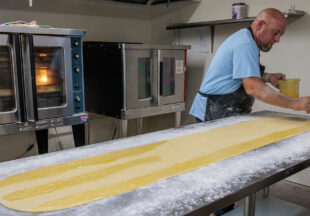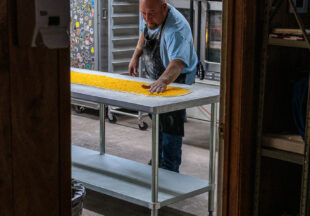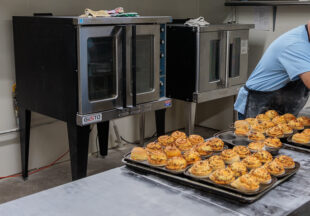Stephens County sees spike in COVID-19 cases, local testing limited

By Tony Pilkington/Breckenridge Texan
Like the rest of the country, state and world, Stephens County continued to see a spike in COVID-19 cases last week. As of Friday evening, Jan. 7, Stephens Memorial Hospital was reporting a record 141 active cases in the county, with three COVID patients in the hospital and 10 tests still pending.
“Yesterday (Thursday, Jan. 6) was 127, and then the day before that was 104. It’s pretty rapid,” said Chris Curtis, Director of Business Development for SMH. “Resource Care has been having, you know, eight to ten, seven or eight a day; they’re having their share as well.”
Until last week, Stephens County had never had over 100 active cases, said Curtis, who is responsible for tracking COVID-19 cases in the county. “You know, we got up in the 80s to the low 90s, and then it would drop off. So we far, far exceeded our highest number, and it really doesn’t look like it’s slowing down.”
He said the test results from both Resource Care and SMH are combined to come up with the total number of active cases for Stephens County.
Testing supplies are limited
In addition to the spike in active COVID-19 cases, another challenge the hospital and clinics are facing is a limited supply of testing kits. Curtis said that, because of the limited supplies, only people with symptoms are being tested. He said with the way the virus has been evolving and the limited testing supplies, the situation can be challenging for doctors.
Limited testing also creates a problem for workers whose employers require them to have a negative test before they can return to work. Curtis said they currently are not able to do those tests since SMH has to concentrate on taking care of sick people and focus on testing people with symptoms.
He has been working with County Judge Michael Roach and the Breckenridge Chamber of Commerce to find a testing solution for employees and businesses needing tests.
In the past, the Chamber had received an allotment of do-it-yourself COVID tests to distribute to local businesses, but all those have been distributed and used up, he said.
Additionally, Curtis said, a program was rolled out last week to provide home test kits to rural health clinics like the Breckenridge Medical Center to distribute. He said they immediately ordered 1,000 of the tests, but he does not know when they will arrive. There are also discussions underway between the federal government and the U. S. Postal Service to deliver test kits to homes across the United States, but there are no details available yet on how that will work or when the tests will be shipped.
“So there seems to be a big push in getting out home tests to people,” Curtis said. “They’re trying to do that through (rural health clinics) and every other form of distribution. So because…if people wake up and feel bad, they can go ahead and test right then and there instead of going out and exposing 15 people. And I think that is definitely a step in the right direction for people to be able to have access to that. That way, the people that are asymptomatic, needing a negative test to go back to work, aren’t clogging up the ER and urgent care clinic unnecessarily.”
As for the County being able to acquire additional tests from the state, County Judge Michael Roach said that while the county can request medical supplies, such as the COVID-19 tests, from The Texas Department of Health Services using a State of Texas Assistance Request, the supplies are very limited.
“I called them last week, and they’re very, very limited, too, on what they can get a hold of, the state is,” Roach said. “And what they’ve done is allocated a lot of those supplies first and foremost to nursing homes and those types of facilities.”
He said what private employers may have to do is just try to find a way to purchase the tests, like the over-the-counter rapid COVID-19 tests, from the private sector where they can find them available. Or, he said, they may have to adjust their policies to use the latest CDC guidelines for returning to work after testing positive for COVID-19 without receiving a negative test.
“They (employers) may have to be less insistent on a negative test for work policy,” he said. “If they’re going to require them, then they’re going to have to find a way to get that test done. Because it’s just not gonna be available in the short term right now.”
Affecting patient transfers from SMH
SMH and Stephens County are not the only hospitals and communities in the area that are being affected by the spike in COVID-19 cases. And because of the spike, Curtis said, with the increasing numbers of COVID patients being hospitalized in the regional hospitals, it’s starting to get harder to find hospitals with enough rooms and staff available to transfer non-COVID patients to.
“You know, we had somebody in the ER almost 24 hours that needed an ICU bed, and it took them about 24 hours to find one,” he said. “And so we’re back in that boat where it’s taking a whole lot of phone calls.”
On Wednesday, Jan. 5, Hendrick Health in Abilene moved their COVID-19 Community Safety Dial to “Level 5: Critical.” On Thursday, Jan. 6, Hendrick reinstated its visitation policy to one person at a time per patient in a Hendrick facility.
As of Friday, Hendrick had 86 people hospitalized for COVID and, of those, 25 are fully vaccinated. “Twenty-five of those are fully vaccinated, which is a huge percentage,” Curtis said. “That’s almost 30 percent, and in the past it has been much smaller.”
For example, he said on Dec. 22 they showed 25 people hospitalized for COVID and only one was fully vaccinated. “So that was a much, much smaller percentage,” he said.
However, Curtis said, he didn’t know how many patients in Hendrick were in ICU and how many of the ones in ICU are fully vaccinated.
Different symptoms than in the past
While the medical staff at SMH and the clinics have no way of determining the exact variant that is causing the current spike, Curtis said they assume it’s being caused by the omicron variant because of how contagious it is and the different types of symptoms they’ve seen.
“We don’t know (for sure),” he said. “There’s only one lab in the state of Texas that has the ability to determine that, because it’s basically a DNA test to detect what strain it is. But this one is clearly way more contagious. And it’s just completely different.”
For example, he said, a lot of the people who are testing positive are having gastrointestinal issues and not respiratory issues and are not losing their sense of taste or smell.
“Some of the people that are out right now say it’s just like having a bad stomach bug,” he said. “And a lot of people think that’s what it is. And they come in (saying) ‘No, no, I don’t have COVID.’ You know, we go ahead and test them because they’re sick. And sure enough, there it is.”
As the pandemic has continued to linger, Curtis has worked to improve his tracking and gathering more information on the cases they’ve had, which he said has resulted in some interesting data. For example, for 28 of the people who have tested positive recently, this is their second time to have COVID-19. For the majority of them it was year to a year and a half ago, when they first had the virus.
“You know, it’s not like they just had it a couple of weeks ago,” he said. “And I personally know a couple of them, and I’ve spoken to them, and they’re like, ‘No, this is different. This, it’s the flu. I just know, it was the flu.’ It’s not,” Curtis said.
He also said this time they’ve seen a wide-range of age groups that have tested positive. The ages have ranged from patients who are under one year old to those in their 80s and 90s.
“We’ve had several under one,” he said. “At the beginning (of the pandemic), it really was age and comorbidities (that) really was the determining factor. There were a few random ones, but now, it’s just everything in between. There’s no, real common denominator. Like at the beginning, it was people that had COPD, or were older, all these different things. Whereas now, it’s anything goes.”
Hospital Staffing and workload
Additionally, Curtis said, because of the current spike, staffing at the hospital has been more of a struggle this go around. He said they seem to have more staff out than they have previously.
He said when the hospital needs help with nursing shortages, they work with an agency and pool of PRN nurses, nurses who don’t work set schedules but fill in as the need arises. The acronym PRN is a Latin phrase commonly used in the medical field that stands for “pro re nata,” which translates to “as the need arises.”
As an example, he said, over the weekend one of the hospital’s former nursing directors who now works for a different hospital, was going to come in and fill in.
“In healthcare, you always keep a bucket of those PRN folks that can kind of plug the holes,” he said. “So it’s kind of nice to have those and especially when they’re local people that know the facility and know the computer system and all that kind of stuff. So we’re keeping it patched together.”
He said having employees cross-trained has helped out, too. “This week, I’ve been covering a couple of different things, because someone is out. So that’s why it’s good for us to all cross train and know more than one thing, because you never know when something like this can happen,” he said.
Moving forward, following CDC guidelines and getting vaccinated
No one knows for sure when the current spike is expected to peak in our area and begin to decline, but Curtis said that everyone needs to take precautions to stay safe. SMH continues to recommend that everyone follow the CDC guidelines of wearing masks, washing their hands and getting vaccinated.
“Because, even though people are getting sick, the physicians have all said, ‘Yes, people are getting sick. But if they had not had that vaccine, they most likely would be far sicker if not hospitalized.’ Which is the same thing with the flu shot. You take the flu shot, and sometimes you may still get the flu, it’s just a lot less severe,” he said.
Currently there is plenty of the COVID-19 vaccine available locally, Curtis said. There is no cost for the vaccinations, and they are offered at Resource Care, Walmart Pharmacy, CVS and on Wednesday afternoons at the Breckenridge Medical Clinic.
“So there’s lots of opportunities to get the vaccine,” he said. “Every week…there’s people on the list…it always makes me happy when I see somebody on there and it’s their first dose. So we’re still seeing…people that have not been vaccinated yet, getting it.”
Also, on Monday, Jan. 31, in honor of National Blood Donor Month, SMH will be hosting a blood drive, and anyone who donates blood will have their blood tested for COVID-19 antibodies. The results will tell them if they had COVID-19 in the past, even if they didn’t have symptoms and didn’t realize they had it.































































































